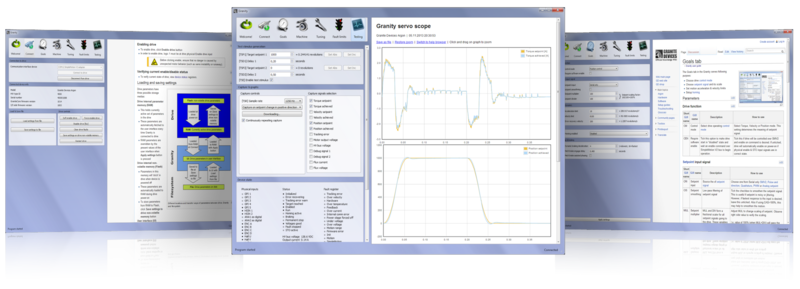Difference between revisions of "Granity"
From Granite Devices Knowledge Wiki
| [checked revision] | [checked revision] |
(→Download) |
(→Version history) |
||
| Line 60: | Line 60: | ||
*Saving graph raw data to .csv file possible | *Saving graph raw data to .csv file possible | ||
|} | |} | ||
| − | |||
==Bugs and TODO's== | ==Bugs and TODO's== | ||
Revision as of 11:10, 30 October 2015
Granity is the configuration software tool for Argon (servo drive). Granity is a successor of GDtool software.
Contents
[hide]Design
From GDtool times, Granity has been redesigned from ground up and aims to deliver effortless setup of servo drives while keeping functionality and reliability maxed out.
Download
Download the latest release from the link below. To run Granity, just extract the Zip file and launch Granity.exe. Installation is not needed.
Drivers
In most cases Windows detects the SimpleMotion V2 USB adapter as USB Serial port and is able to install drivers automatically. However, if not, download VCP (Virtual COM Port) drivers from this page. The recommended package is the setup executable (direct link).
Documentation
See main article Granity user guide
Version history
| Version | Release date | Change log | Remarks |
|---|---|---|---|
| 1.0.0 | 1.9.2013 | Initial release | Requires Argon firmware 1.0.0 |
| 1.0.1 | 3.9.2013 |
|
Requires Argon firmware 1.0.1 |
| 1.0.2 | 18.9.2013 |
|
Requires Argon firmware 1.0.2 |
| 1.1.0 | 6.11.2013 | Requires Argon firmware 1.1.0 | |
| 1.5.0 | 19.3.2015 |
|
In this package version there are two executables (Granity-ARGON.exe and Granity-IONI.exe). Use the one intended for your drive model. |
| 1.6.0 | 15.4.2015 |
| |
| 1.7.0 | 4.5.2015 |
| |
| 1.8.0 preview, not yet official | 29.5.2015 |
|
Bugs and TODO's
Known bugs
- Halls enabled & Granity connected & drive restart -> starts spinning and follow error faults - fix attempt done
- Serial numbers read -1 when loading .drc file
Suggested features
- User settable temperature fault level
- Add mm/min and inches/min speed units
- Add zero offset function for Analog & PWM setpoints - can be done by making setpoint scope and calculating average and then the offset value
